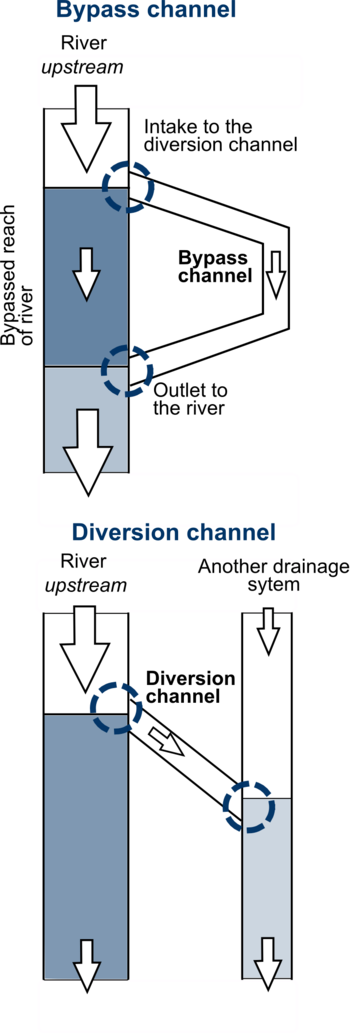Bypass channels divert river flows from a point upstream of an area requiring protection. These diverted flows can be discharged back to the same river, herein referred to as a bypass channel or into another natural drainage system nearby, herein referred to as a diversion channel. Gates regulate flow into bypass and diversion channels. Functioning of a bypass channel depends mainly on its location, length, carrying capacity and inlet characteristics. While a bypass channel reduces flood magnitude in the bypassed area, it may increase flooding farther downstream, as floodwaters are rushed through the bypass channel. A diversion channel can increase the possibility of flooding in the receiving drainage system downstream if the diverted flows are larger than its carrying capacity. Detention or retention basins, constructed in conjunction with the bypass system, can avoid such situations.
Impacts of bypass and diversion channels on sediment balance depend on whether or not the intake allows for bed load passage from the river into the bypass. If the bypass channel only draws floodwaters from the river without carrying its share of bed load, increased sediment concentration in the bypassed reach of the river can induce deposition, therein leading to aggradation. Combined with the subsequent encroachment by riparian vegetation, this can potentially decrease the conveyance capacity in the bypassed reach. This can be avoided if the bypass channel is appropriately designed to draw its share of bed load from the river. This enables the bypassed reach to attain a new dynamic equilibrium under its new flow and sediment regimes, maintaining its ecological health. The same can be said in the case of a diversion channel after a new dynamic equilibrium is attained by the drainage system where the diversion channel is discharged.
However, if a bypass channel diverts flows at all stages, thereby affecting the low flows, habitats and vegetation in the bypassed reach of the river are likely to be affected. With reduced flows in the main stem of the river, streamside vegetation can encroach into the river channel, thereby changing its physical character. Such altered flow conditions often favor exotic species, which places greater survival pressures on native species. A bypass channel has no appreciable impact on the quality of the water in the river or diverted floodwaters. (WMO 2006a)
